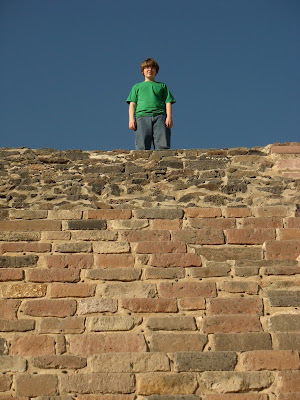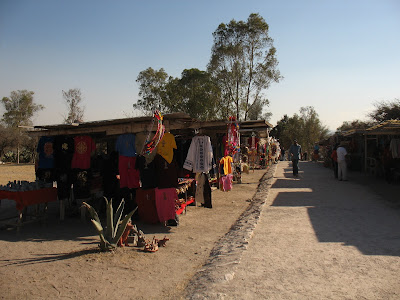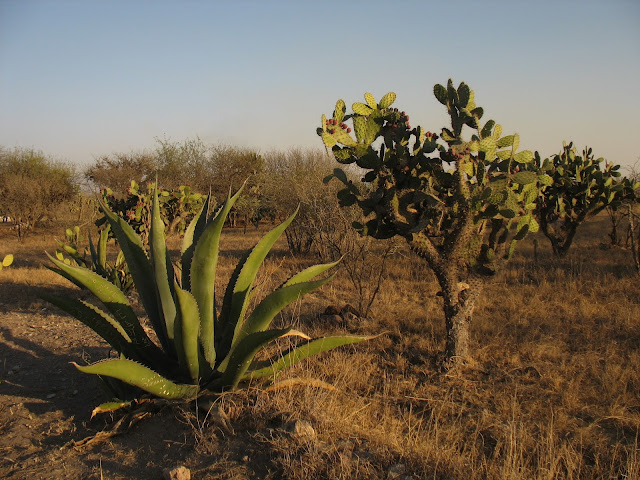We had originally planned to visit an ancient pyramid on Monday until it was brought to our attention that the State owned properties are all closed on Mondays, so we rearranged the plan and convinced
Gerardo that I could manage to navigate my way to Tula and back without him. Did I mention he's a nervous Nelly? It's all in our best interest, I know, and I love him for it.
We all met for breakfast out and I thoroughly enjoyed my plate of eggs over easy on crispy tortillas, topped with mashed beans, salsa, peas, and fried banana slices then Joshua, Alexandre, our new speaking-only-Russian-and-some-German friend, and I headed out to find the giant Aztec warriors suggested to be part of the fabled sity of Atlantis.

 The drive was not too long but gave us a good look at the countryside, which seemed to change somewhat as we got further west to Tula. What is all dry and dusty terrain dotted with small shrubs and cactus here in Pachuca, became bright green with some sort of low growing crop, on shallow terraced farms, lined with deciduous trees. We saw a heard of cows for the first time, grazing on what looked to be just dirt. Pachuca is in what is called de La Plata, because it is a wide, flat plain, but we were getting into more hills and passing small mountains on the way to Tula. I later learned that the River Tula irrigates this region which is what made it attractive to early pre-Columbian settlers.
The drive was not too long but gave us a good look at the countryside, which seemed to change somewhat as we got further west to Tula. What is all dry and dusty terrain dotted with small shrubs and cactus here in Pachuca, became bright green with some sort of low growing crop, on shallow terraced farms, lined with deciduous trees. We saw a heard of cows for the first time, grazing on what looked to be just dirt. Pachuca is in what is called de La Plata, because it is a wide, flat plain, but we were getting into more hills and passing small mountains on the way to Tula. I later learned that the River Tula irrigates this region which is what made it attractive to early pre-Columbian settlers.Early in our journey, we stopped to refuel and were delighted to notice that behind there was a saddled horse tethered behind station indicating that someone there rode him to work, and probably does so every day. We missed our highway but corrected that quickly and found Tula without another glitch. Finding the pyramid was another matter as the little blue signs with the picture of one were no longer anywhere to be seen now that we had reached the town. Joshua helped me muddle through a few inquiries with willing locals to no avail. Gerardo had mentioned to look for Atlantes ze Tula, at least I think that's what he said, and pyramid is very similar in Spanish, but it wasn't until we realized that there were signs for Zona Archeologica that we found our destination. It was spectacular.
A gravel path led us from the entry gate and museum, through a few alleys of craft and souvenir stalls, past a little white hacienda, and finally opened onto the site. To the right was the small Plazuela Norte (northern square) with its large ball court measuring 220ft by 41ft. On the left was a nearly full pyramid, the Temple of Quetzalcoatl, also called Pirámide de Tlahuizcalpantecuhtli, crowned with a group of tall sculptures.

Joshua ran ahead to see how accessible it would be for Alexandre and found a corridor of bas relief figures that we could all investigate just at the base of the little pyramid. It was amazing to me how unprotected the artwork was, and even more impressive was how poignant the imagery is to this day. I do not know anything about the Toltecs but found their symbols and style intriguing and captivating. How fortunate to have been face to face with this skillful and ancient work called The Coatepantli, or Wall of Serpents. Skeletons emerge from the mouths of the serpents, accompanied nearby by eagles and jaguars, all of which represent military activity of Mesoamerica.
All of my knowledge regarding Tula is taken from translation so I cannot be certain I've got it right but I'll share what I gleaned.
The legend was that around 800 AD, Quetzalquatl and his followers were expelled from the capital city and marched South where he founded the city of Tullan, his new capital of Mesoamerica. This city grew to 16 square kms, adopting traditions of the Maya, and remained the leading political, military and commercial center of the civilization for many generations. For most researchers Tullan was regarded as a myth until the 1940's when important archaeological study began here at Tula, about 80 kms from Mexico City. Some, however, question the connection between Tula and Tullan. By the 13th century, the city had declined and the Aztecs moved in from the North, merging cultures with the Toltec, which, in my novice opinion, is visible in the artwork.

Some of the visitors were sitting on the edge of the little pyramid christened Pirámide de Tlahuizcalpantecuhtli, or Pyramid of the Morning Star, enjoying the view. We briefly stopped to look at the columns of the Presidential Palace, where political functions would have been held, took in the view of the ceremonial pyramid, then Joshua ran up the steps to see the Antlantes atop the little pyramid.
 |
| Pyramid C, the ceremonial center |

The warriors, or Atlantes, stand about 15 feet tall and each have distinct features, which I understand has stumped some archaeologists regarding their ethnic representation. They wear winged shields on their chests and carry an atlatl used to launch arrows. They would have supported the temple roof and been feared by enemies, which I could not fathom as I found them quite benevolent.

 |
| The Presidential Palace |

It was wonderful to have complete access to the ruins without disruptive rails and Joshua delighted in creeping right to the edge to look down. The views were breathtaking and that ever present, gentle breeze made it so comfortable. I was completely enamoured with the site and I didn't dare sit down knowing that I would never leave.

 |
| We could see the flames of the refinery stacks in the distance dissolving all illusions of visiting an ancient time. |
Joshua descended the steep stairs noting that going down felt a little more dubious, but he soon returned at full speed in search of money. Evidently, the men on the walk were selling artifacts. My sweet boy. I delicately explained that these would be reproductions and that some vendors may stretch the truth a little to make a sale, never wanting to render him cynical. So the souvenir shopping began. He did purchase a jade jaguar from the men after some deliberated discussion and calculations. I had a momentary panic when I thought we'd just paid fifty some dollars, but he corrected me and he was so taken with the little carving that I recovered relatively quickly.
I was looking forward to doing some souvenir shopping on the way out because I had noticed many things that represented Mexican culture to me, some hand crafted things like I had hoped to find, as opposed to the shops in Real del Monte that offered more modern items. An embroidered peasant blouse is on my list
and I saw several but none of them appealed to me greatly. I was luckier with ceramics, although I may rethink the term lucky as I struggle to lift my suitcase into the overhead compartment on the plane tomorrow. (tomorrow - ugh!)
Joshua had mentioned wanting to haggle but at the prices they were offering, I didn't really feel the need. Another thing I was looking for was a substantial string of stone beads, reminiscent of what Frida would wear, and it didn't look promising but I happened upon a set of obsidian, which is prevalent in the area, and turquoise, which I've always found attractive. Doing the math in my head is a chore and I can never anticipate the conversion so I was shocked when the price came out to $5. How can you argue with that?
 |
| I'm not sure how I missed the spiraled snake in this serpentine garden on the way out but I was pleased to discover him as we made our way to the exit. |
 |
| Joshua and I both love the cactus plants. They are even bigger than I anticipated, and everywhere. |
It was just getting dark as we left the town of Tula so we got to enjoy a vast sunset on the way back to Pachuca. From the highway you could often see for countless miles. Unfortunately, it was a little too dark to get a good photo when we came across a herd of cows being driven down the overpass.

























No comments:
Post a Comment